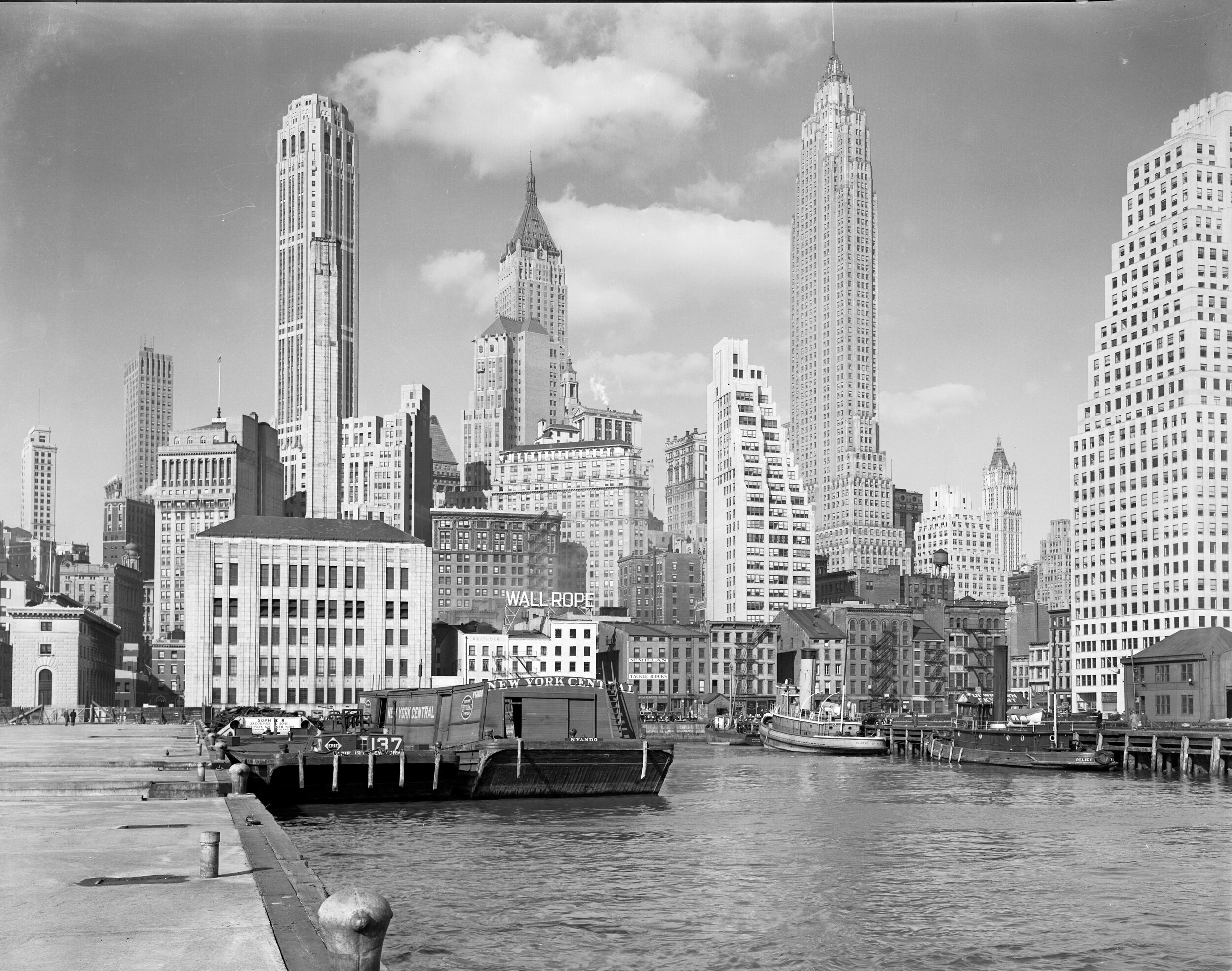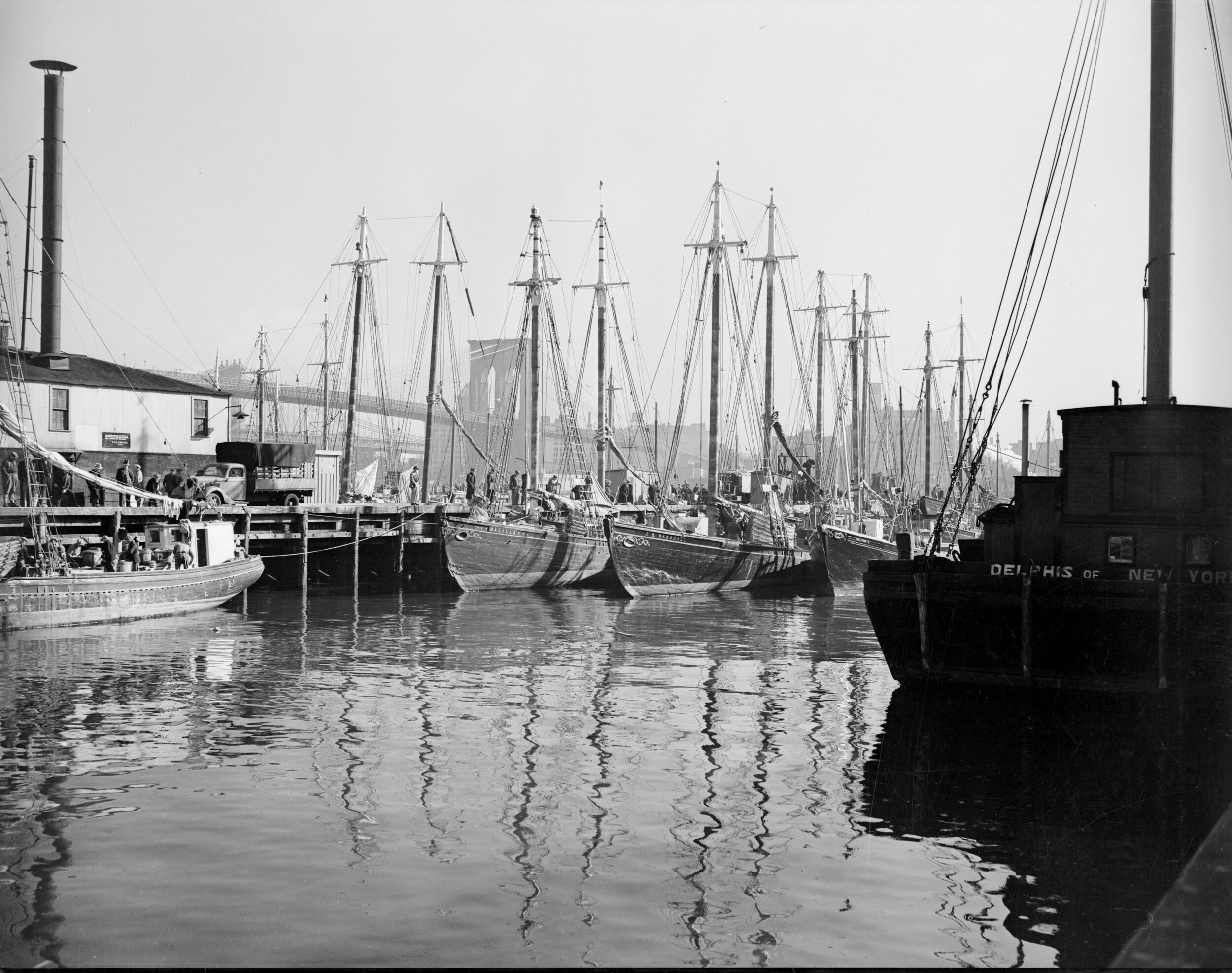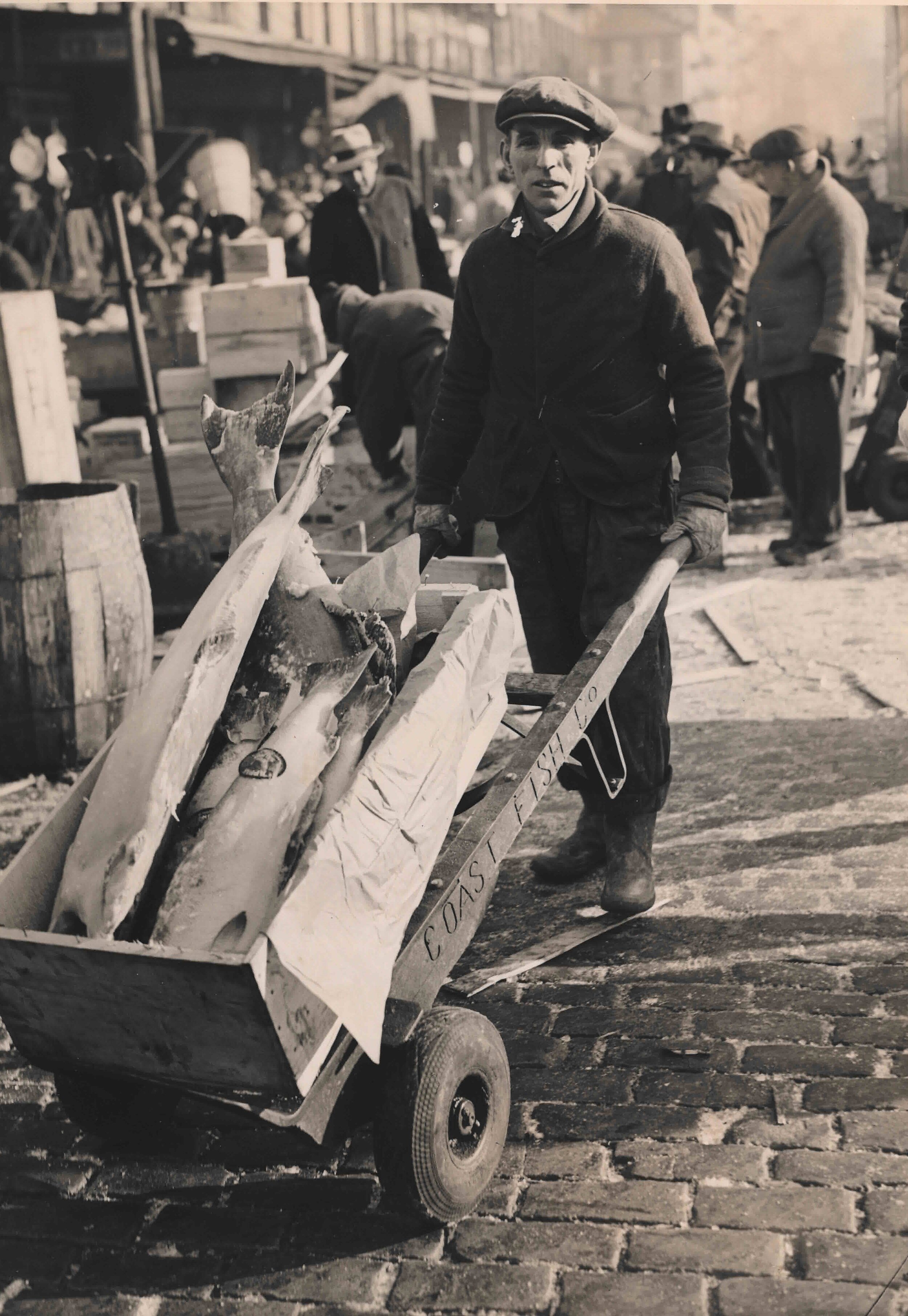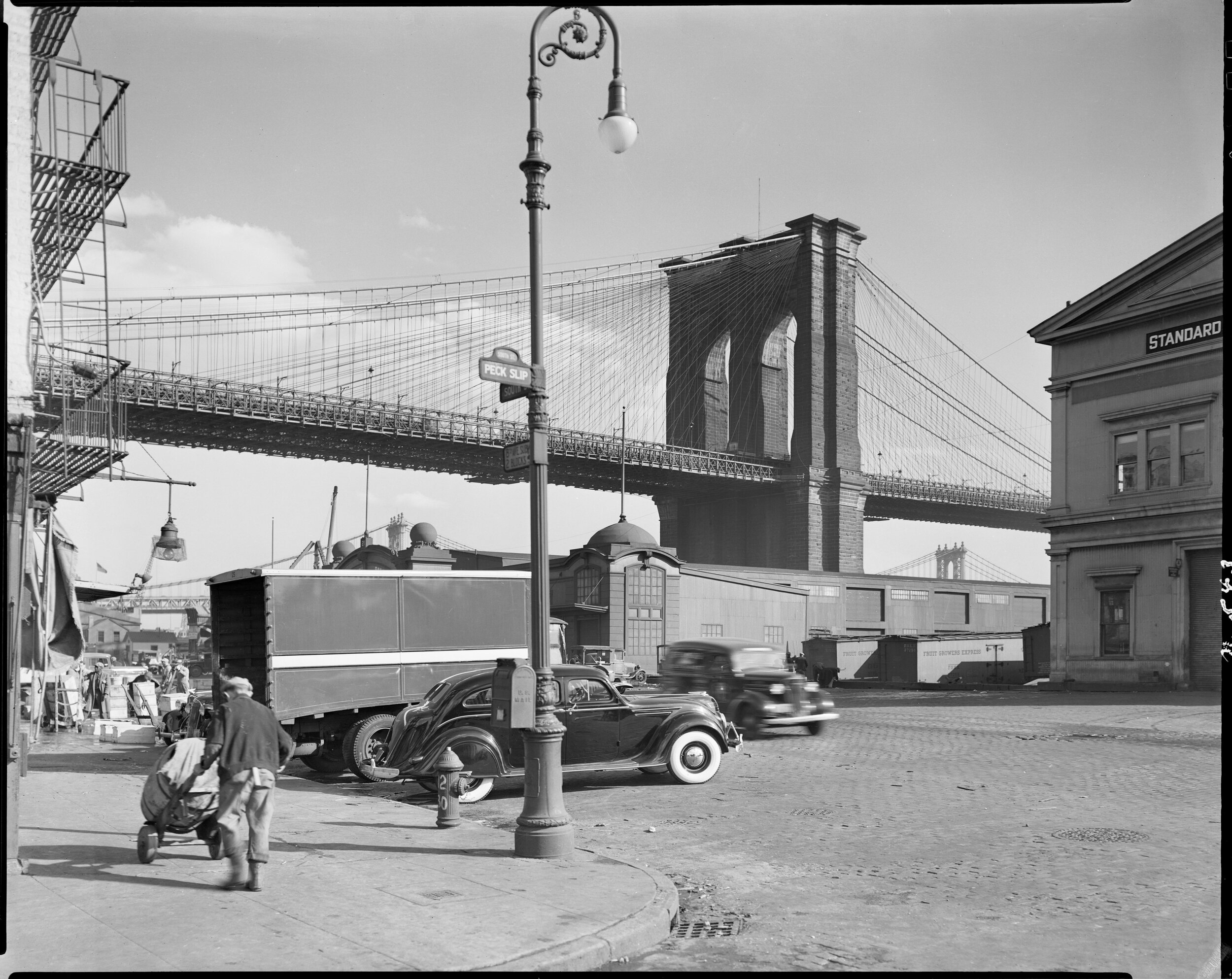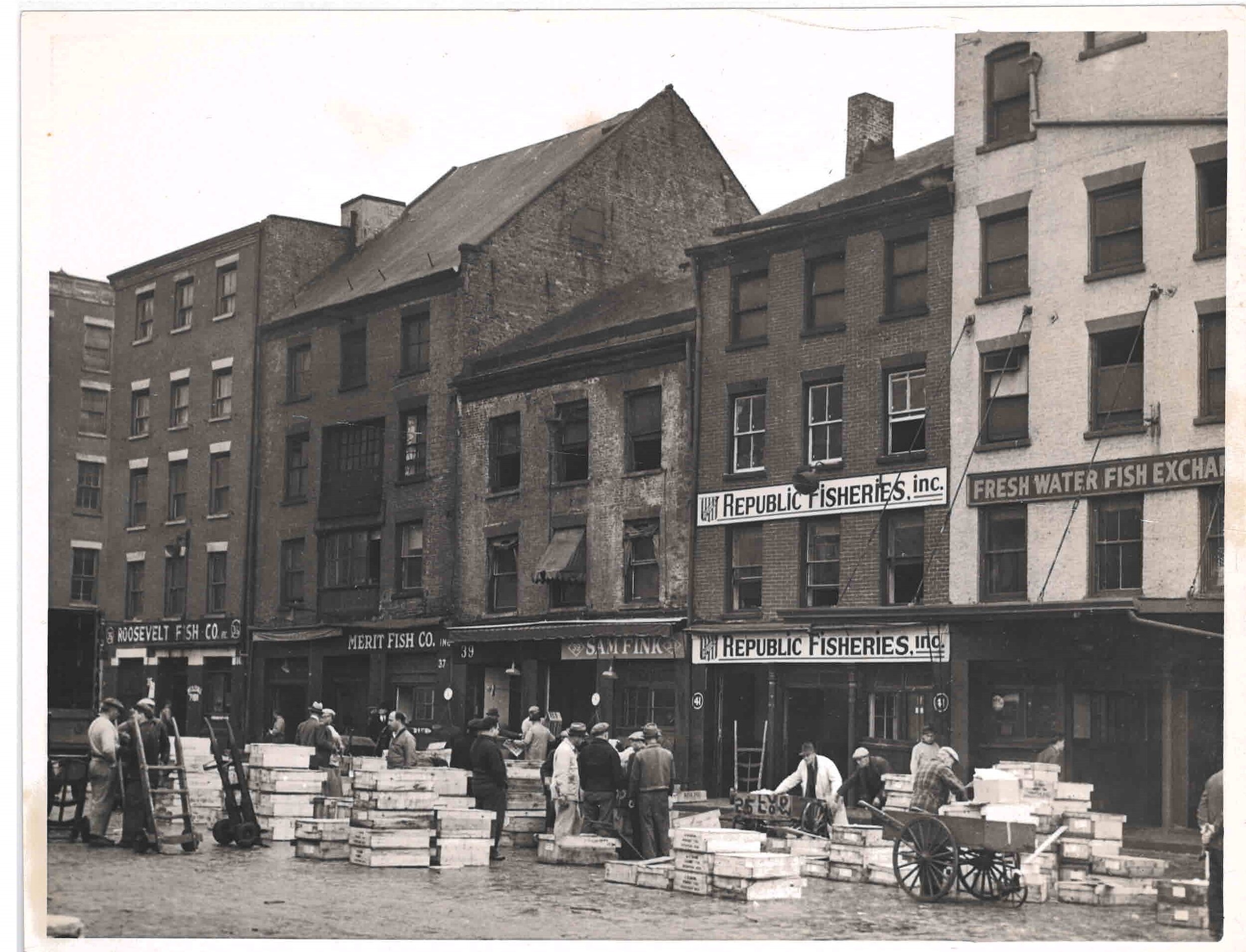Our recent blog highlighting Municipal Archives collections that document the New Deal included a description of the records of the New York City Unit of the WPA Federal Writers’ Project. The NYC FWP provided meaningful employment for more than 300 writers, journalists, editors and photographers during the Great Depression. Although the collection includes research materials and draft manuscripts for 64 books, only a handful were published, notably the New York City Guide, and New York Panorama.
This week we are posting an article about the Fulton Fish Market from one of the unpublished manuscripts – Feeding the City. As is typical of many FWP manuscripts, the name of the author is not clear (it may have been “McLellan”), but it is dated: October 1940.
“Manhattan Casts its Reflection in East River,” South Street, from pier, ca. 1937. WPA Art Project Photograph. Photographer: Suydam. WPA FWP Collection, Municipal Archives.
No other wholesale market anywhere offers such an extensive supply of sea food as Fulton Fish Market. London’s famous Billingsgate has long been the world’s largest fish market, but in variety Fulton far surpasses it. During the busy season, early spring to late fall, 160 varieties of fishes and shellfishes from all parts of the world are available here to the 1,633 retail outlets that cater to the City’s diverse tastes.
Fishing boats at the dock, East River, November 1937. WPA FWP Photograph. Photographer: E.M. Bofinger. WPA FWP Photograph Collection, NYC Municipal Archives
Delivering halibut, Fulton Fish Market, ca. 1937. Fishery Council Photograph. WPA FWP Collection, Municipal Archives.
The Department of Markets estimates that no more than one-quarter of these fishes and shellfishes arrive by boat. The bulk is brought in trailer trucks from railroad terminals and points along the coast. Fresh-water fishes such as eels and carps, bought by certain racial groups, are shipped in alive by rail or are water-borne by Hudson River barges. Freshly caught whole fishes come in by the boatload, but gutted and packaged fishes, both fresh and frozen, arrive by truck from sheds and icehouses adjoining the landing piers in the ports of Boston, Gloucester, and New Bedford. Enormous frozen swordfishes, stiff salt cods, and millions of tins of sardines, sprats, tunas, mackerels and kippered herrings arrive by tramp steamers and transatlantic freighters. Not more than 10 per cent comes from waters contiguous to the City. The major portion is from commercial fisheries whose boats operate on the Newfoundland Banks and off the New England coast, from Gulf fisheries, and those of the Pacific coast. The greater part of the live-lobster supply comes from Maine, while from South Africa come large shipments of frozen tails of the spiny lobster. Other varieties of frozen or preserved fishes and shellfishes come to Fulton Fish Market from points as far distant as Japan, the Baltic states, Portugal, North Africa, and Alaska. Dried and flaked fishes are shipped from Newfoundland and Nova Scotia, from Maine and Massachusetts. From the Mississippi and its tributaries in the southern States and from the Great Lakes arrive the fresh-water fishes so important in the diet of the City’s Jewish population.
South Street, near Peck Slip, October 1938. WPA Art Project Photograph. Photographer: Libsohn. WPA FWP Collection, Municipal Archives.
The day’s work begins in Fulton Market at 2 a.m. when trawlers, draggers, and smacks draw into the docks along the lower East River to discharge their cargoes. Selling begins precisely at 6 a.m. when a gong clangs three times. Buyers, representing jobbers and retailers, scurry among the stalls of the market’s 100 wholesale dealers, making their selections. Stalls are on piers, in the market’s new buildings, and in the nine-block area west of South Street.
Fish vendors, South Street, ca. 1937. WPA Federal Writers’ Project Photograph. Photographer: Clifford Sutcliffe. WPA FWP Collection, Municipal Archives.
Ninety per cent of the market’s sales are handled on a commission basis and selling must be concluded by one o’clock in the afternoon. After the boats unload, workmen begin wielding knives, cleavers, clippers, and scalers, preparing tons of fishes, and arranging them on beds of cracked ice for rush delivery to jobbers and retailers. The action along the waterfront is fast and furious since fish is one of the most perishable of commodities.
Hundreds of trucks are unloaded along the sidewalks where countless crates, vaporous and dripping wet from over-night refrigeration, are piled high. Empty trucks rumbling away are replaced by others belatedly reaching their destination. Retailers’ and jobbers’ trucks are loading up, a seemingly interminable stream of vehicular traffic.
Sidewalk stand, Fulton Fish Market, October 1937. WPA FWP Photograph. WPA FWP Collection, Municipal Archives.
“Whale and five chickens,” shouts a floor salesman, moving about in thick-soled rubber boots. A handler disappears into a refrigerated compartment and emerges hugging a huge halibut and five small ones. He drops these into a barrel and the “whale and five chickens” are ready to be packed for the last lap of their journey from the salty depths to the neighborhood fish store.
Monday is the big day at Fulton Fish Market. Produce sold on Mondays is in the retailers’ stores on Tuesdays, and so the shrewd housewife does not have to wait until Thursday or Friday to shop for sea food. On Tuesdays, stocks are fresher and larger, and prices are apt to be lower than during the rush later in the week.
When South Street was a cobblestone thoroughfare, unpleasant odors hung over this 200-year-old market. Today odors are being banished, for South Street, 75 feet wide, is now paved with asphalt, and new buildings constructed between Piers 17 to 20 by the Department of Markets form the beginning of a model fish market.
Peck Slip and South Street, ca. 1937. WPA Federal Art Project Photograph. WPA FWP Photograph Collection, NYC Municipal Archives.
The huskies who man the fishing boats are among the most picturesque of those who go to sea for their living. Many are of Norse origin. Others are down-easters whose Yankee forebears fished the banks along the North Atlantic coast; Portuguese, Italians, and Newfoundlanders also form a large group. Like other seafarers, these fishermen have their superstitions. Few will leave the piers on Fridays. When the Friday morning rush is over, they descend into their cabins and sleep until Saturday morning, or wander along South Street on shopping tours.
The entire supply of sea food once came by boat, but the fishing fleet is gradually diminishing. Skippers in the distant fishing grounds head their craft for home port, to load the catch into railway express cars or specially constructed trucks with insulated bodies, which rush to the wholesale markets. The airplane, too, enters into the picture, bringing from the west coast, southern, and Canadian waters luxury sea food such as turtle, terrapin, salmon, pompano, Florida crabmeat and stone crab, mountain stream trout, and frog’s legs. Many of these expensive products are packed in special tins and cartons for flight to LaGuardia Field, and are trucked to the market or delivered direct to retail outlets, clubs, and hotels.
Peck Slip, between Front and South Streets, ca. 1937. World Telegram Photograph. WPA FWP Collection, Municipal Archives.
New Yorkers expect many types of food to be available at stores and markets. This manuscript shows that this is not something new but a long standing tradition.
